Versailles currant - description and characteristics of the variety
White currants are steadily popular among domestic gardeners. The fruits of this plant are less likely to cause allergies than brighter berries. They have a refreshing sweet and sour taste and delicate aroma, which differ significantly from black and red varieties of currants.
White currants are more demanding to care for and less productive than black or red ones. However, among the varieties of white berries there are more hardy and productive varieties. One of them is Versailles.
Description of white currant variety Versailles
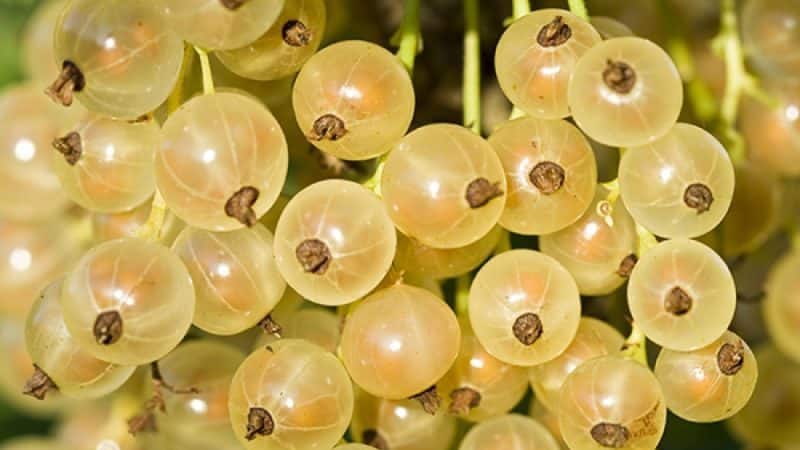
White currant (ribe niveum) is a fairly old variety, bred in France back in the 19th century. Only in 1959 the plant was included in the State Russian Register. It is recommended to be grown in regions with a temperate climate, but it is suitable for cultivation in the south and even in the north of Russia.
Main characteristics
Despite the presence of many more modern varieties, Versailles white currant is not inferior to them in many respects and even surpasses many varieties and hybrids bred today.
Description of Versailles white:
- Bush. Erect. Medium height. The height varies between 1.2-1.5 m. The bushes are spreading, throwing out a large number of shoots. The branches are thin, but quite strong and flexible. The root system is developed. Most of the roots are horizontal, located at a depth of 40 cm underground and grow beyond the crown. The central root is powerful, going underground to a depth of 1 m.
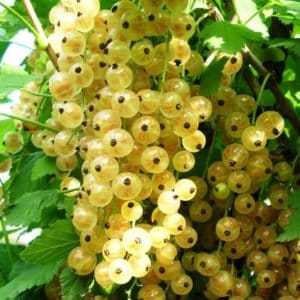
- Leaves. Wide, heart-shaped at the base, with five lobes. The edges are jagged. The teeth themselves are wide and blunt. The underside of the leaf blades has slight pubescence. The color of the leaves is dark green with a barely noticeable bluish tint.
- Bloom. The inflorescences are collected in long sparse racemes with petioles. The flowers are saucer-shaped, medium in size, yellow-white. Pedicels are long and straight. There is no pubescence, there is a glossy sheen.
- Berries. Large, round, aligned, collected in long brushes. The weight of each berry varies between 0.7-1.3 g. The color is creamy. The fruits are translucent, the seeds are visible through the juicy pulp. The taste is sweet and sour, rich. The skin is transparent, thin, but durable.
- Ripening time. Early ripening.
- Immunity. It is highly resistant to powdery mildew. It is not immune to anthracnose. Immunity to other fungi diseases average.
- Resistance to negative environmental factors. Has high frost resistance.
- Transportability. High. The dense skin allows the fruits not to wrinkle during long-term transportation.
- Productivity. High. On average, 3-4 kg of berries are harvested from a bush.
White currants are distinguished by the smooth ripening of their berries. The entire crop is harvested from the bush at once.
Note! Versailles white currant berries contain up to 18% dry matter and 7.5% sugar. The acidity of the fruit is 2.3%. Per 100 g of product there are 38 g of ascorbic acid.
Advantages and disadvantages
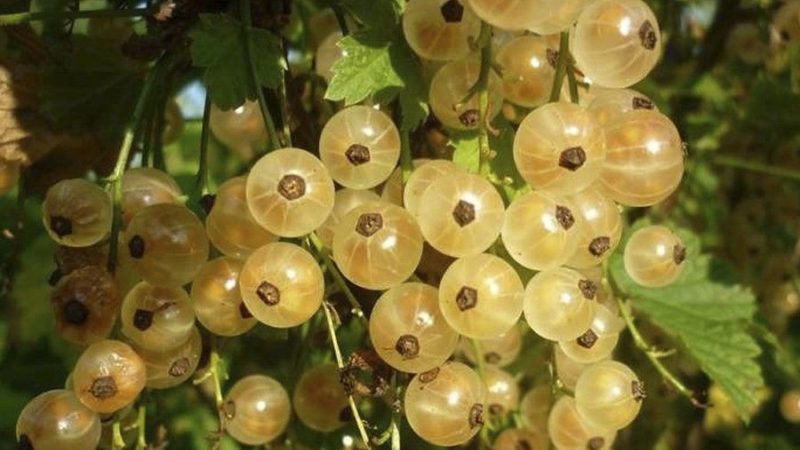
White currant Versailles is popular among beginners and experienced gardeners. Its main advantages are presented in the list:
- High frost resistance. This makes it possible to grow Versailles white in all regions of our country;
- Self-pollinating.The plant will bear fruit even in the absence of other white currant bushes on the site.
- Presence of immunity to powdery mildew. Reviews from gardeners indicate that currants are not susceptible to many other fungal diseases.
- High yield.
- Early ripeness.
Disadvantages include:
- susceptibility to anthracnose;
- excessive spreading of the bush;
- demands on soil composition.
Advice! Despite the fact that the variety is considered self-pollinating, the highest yields are observed when there are several bushes (better than different varieties) of white currant on the site.
Landing
Versailles white reproduces only vegetatively. They use cuttings, propagation by layering or dividing the bush. The technology for obtaining planting material is no different from other varieties.
Ready-made seedlings are usually sold in nurseries and markets. They quickly take root and take root well in their permanent location.
Soil preparation
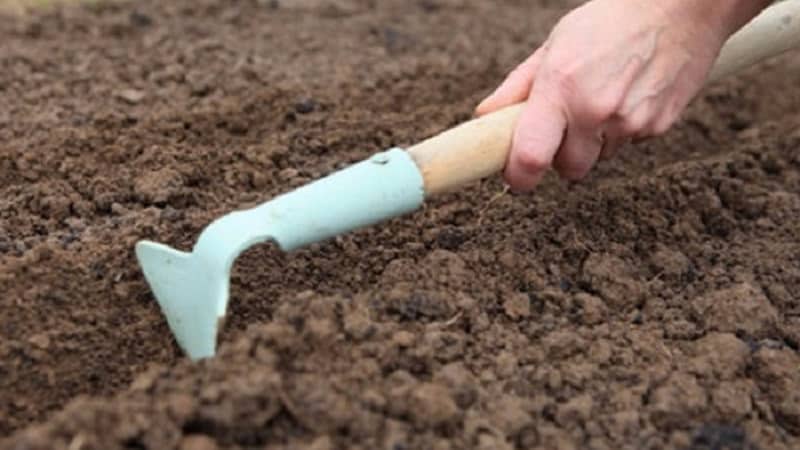
For Versailles currants, it is important to choose a suitable location. It should be located in the most sunlit and wind-protected area of the garden. Groundwater should not come too close to the surface.
Note! With insufficient lighting, the yield of the variety decreases. The berries become small and sour.
Currants do well in nutritious loamy soils, but can grow in any soil. When planting in sandy soils, more intensive feeding will be required.
Before planting currants, the area is dug up and cleared of weeds. Soil with neutral acidity is best suited. If the indicators are elevated, add dry lime or ash.
Currants are planted in early spring or after leaf fall. The holes are prepared 2-3 weeks before planting.
Well preparation:
- The holes are dug 40 cm deep and 50 cm in diameter. There must be at least 1.5 m of free space between plants.
- The soil removed from the hole is mixed with 5 kg of rotted manure, 50 g of superphosphate and 20 g of potassium sulfate. If desired, superphosphate with potassium is replaced with 1 kg of ash.
- The soil and fertilizers are thoroughly mixed and left near the hole until planting.
Step-by-step instructions for planting and choosing a seedling
It is important to choose high-quality and healthy planting material. There should be no traces on the seedling diseases and infections, suspicious spots and plaque. The root system should be well developed, without dry and dense areas, moist at the cut. The branches should not be dry. The greens should be bright with good turgor.
It is better to buy seedlings with a closed root system (located in an earthen coma) - they take root faster. If seedlings with an open root system were purchased, before planting they are soaked in a light pink solution of potassium permanganate and a root formation stimulator. If the roots are long, they are shortened by a third.
Step-by-step landing instructions:
- A 5 cm layer of drainage (fine crushed stone, expanded clay, shell rock) is poured into the bottom of the pit. An earthen ball is formed in the center.
- The cutting is placed on a lump of earth at an angle of 45 degrees. The roots are evenly distributed over the mound.
- The hole is filled with nutritious soil mixture so that the root collar is buried 7-10 cm.
- After planting, the soil around the plant is compacted. Then pour 2 buckets of warm water under the root.
- If the soil has settled, add more soil. A layer of mulch (humus, peat, straw) is poured around the bush.
- The upper part of the seedling is cut off, leaving 5-6 healthy buds.
Growing
To achieve the highest possible yield, it is important to provide the shrub with proper care. Versailles currants are less demanding than many other varieties with white berries. At the same time, it is more demanding than black and red currants.
Care
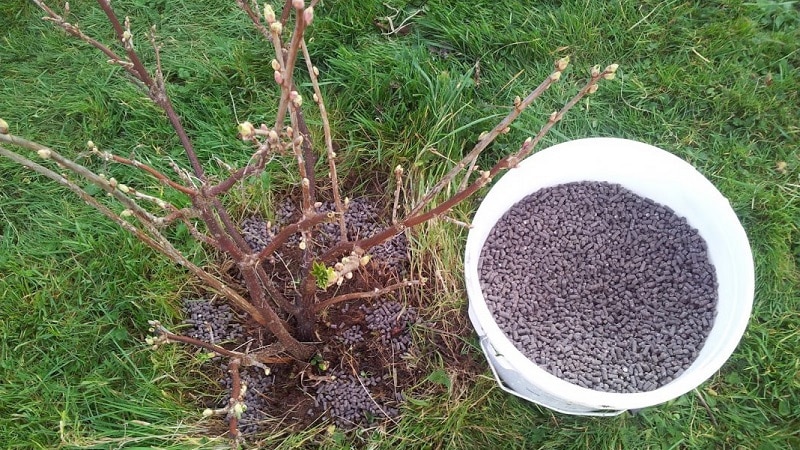
White currant Versailles needs regular care. The list contains the basic rules:
- Watering. White currants require watering. In a normal summer, the bush is watered three times a week, each time using 10 liters of water. If the summer is dry, then the currants are watered every day. During the rainy season, watering is stopped. The soil is moistened with warm, settled water in the morning or evening, when the sun is not active.
- Loosening and weeding. The soil around the currants is loosened after each watering or precipitation. During the loosening process, weeds are removed.
- Feeding. In the first and second years after planting, there is enough fertilizer applied to the soil taken out of the hole. Then they begin to deposit in early spring a solution of 10 liters of water and 50 g of urea, and after harvesting the bush, pour a mixture of 10 liters of water, 0.5 liters of chicken manure (or 1 kg of rotted manure), 50 g of superphosphate and 20 g of potassium sulfate. In summer, the bush is sprayed with a mixture of 10 liters of water, 5 g of potassium permanganate, 3 g of boric acid and 35 g of copper sulfate.
- Formation. The first formative pruning is carried out a year after planting. Of all the formed skeletal branches, 3-4 of the strongest are selected, the rest are cut off. This is how annual pruning is carried out. The crown will form in 4-5 years. By this time the plant should have 16-18 branches. Next, I cut off 7-8 year old branches, leaving replacement shoots.
- Sanitary pruning. Every year, dry and damaged shoots and branches creeping along the ground are pruned. Cut out the shoots.
- Anti-aging pruning. If the currants begin to produce little fruit, then it’s time to apply anti-aging procedures. To do this, currant branches are cut by 2/3.
- Wintering. To ensure that the currant survives the winter safely, its branches are tied with twine. A 10-15 cm layer of mulch (compost or humus) is poured under the bush. In snowy winters, it is enough to cover the plants with snow. If there is no snow, then the currants are covered with agrofibre.
Diseases and pests
White Versailles currants are rarely affected by powdery mildew and blight. According to reviews from gardeners, the variety is susceptible to anthracnose. A diseased plant breaks out in brown spots, which gradually fade and increase in size. This leads to impaired photosynthesis, falling leaves and fruits, and drying out of shoots.
If the disease has already affected the bush, then it is sprayed with fungicides. Before this, all diseased parts of the plant are removed.
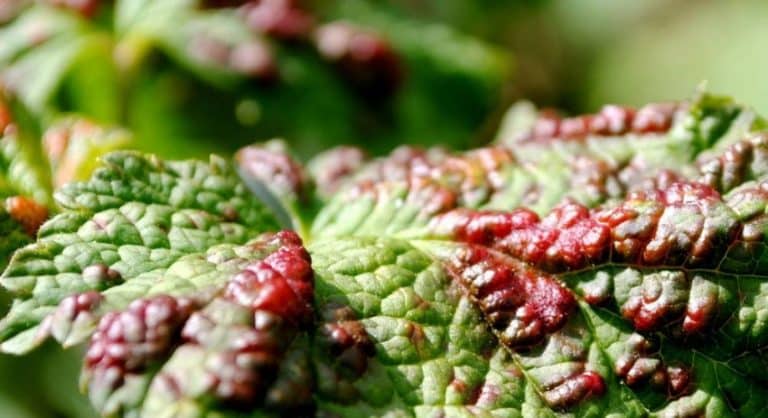
It is important to prevent diseases. The list contains the basic rules:
- Preventive treatments. Carry out in the spring, before the buds swell. The bush is sprayed with Bordeaux mixture or copper sulfate solution. It is recommended to spray after prolonged rains.
- Garden cleaning. In the fall, after the leaves fall, all fallen leaves and dried branches are removed and burned. In summer, remove all weeds around the plant.
- Disinfection. Disinfect soil, planting material, and garden tools.
- Feeding. A plant that receives a sufficient amount of nutrients resists diseases more successfully and pests.
- Compliance with watering rules. Waterlogging, as well as drying out of the soil, are considered favorable conditions for the development of fungus.
- Sanitary pruning. It is on dry and damaged branches that a fungal infection usually begins to develop.Their timely removal is necessary.
- Processing slices garden var.
Currants are affected not only by infections, but also by pests. To protect the plant from them, the disinfection rules presented above are followed, and all fruit and berry plants on the site are inspected weekly.
Harvesting
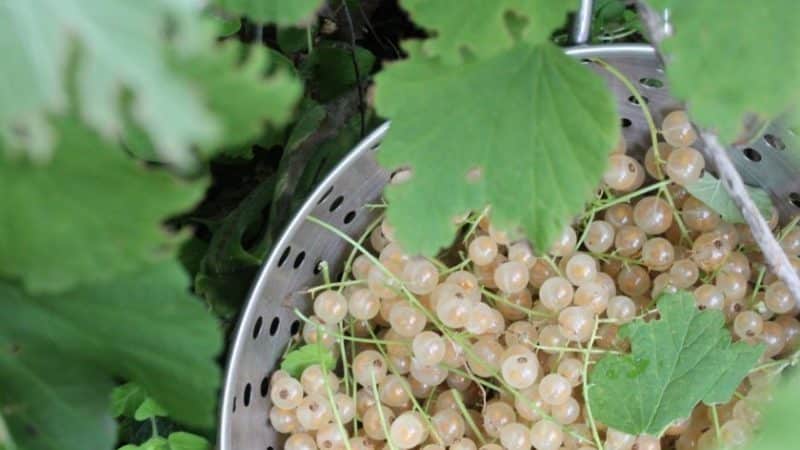
Versailles white berries ripen in late July or early August. When ripe, they do not fall off the bush, so many gardeners wait until all the berries are ripe and collect them at one time.
The currants are picked directly on the clusters. Store in the refrigerator in a plastic bag or closed container for 1-2 weeks.
The degree of ripeness is determined by taste and how easily the berry separates from the stem. In ripe fruits, the seeds are clearly visible through the pulp.
Reviews
Reviews of Versailles white currants are mostly positive. Most gardeners recommend starting your acquaintance with the crop with this variety.
Irina, Moscow: “My mother planted Versailles white currants at the dacha. From that first bush we received many seedlings, which we planted on our site and gave as gifts to friends. Since then we have tried many more modern white currant varieties, but Versailles remains a favorite. It does not drop its fruits during cold spells and does not need watering in rainy summers. All I do is cut off weak shoots and apply fertilizing twice a year.”
Alexander, Rostov “Versailles white currant is my favorite. I like its large fruits on long clusters. Juicy, sweet with a slight sourness. It requires care, but if everything is done on time, it won’t take much time. I add a solution of ash with chicken droppings in early spring and September. I water only if the soil is very dry.There was a year when she fell ill with anthracnose. Since then, I always spray with copper sulfate in the spring and after prolonged rains.”
Conclusion
White currant Versailles is a French variety bred back in the 19th century. It is characterized by frost resistance, high yield, large fruit, and resistance to many diseases. It has only two significant drawbacks - lack of immunity to anthracnose and increased branching of the bush.
Caring for white currant Vernisal is not difficult. The main thing is to ensure timely watering and fertilizing, and to carry out shaping and sanitary pruning annually.